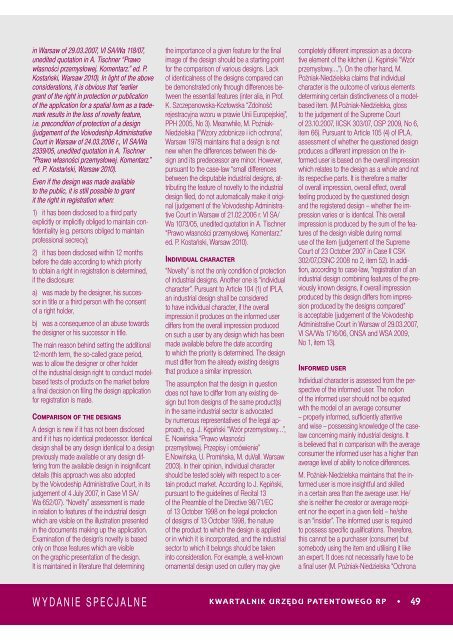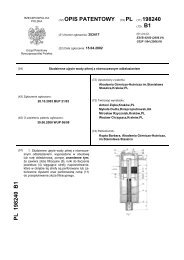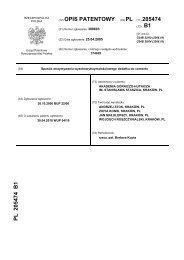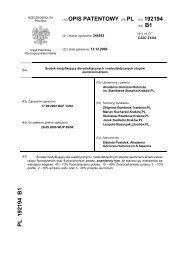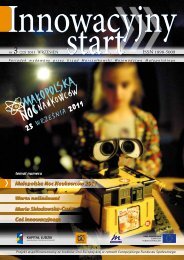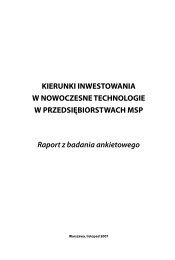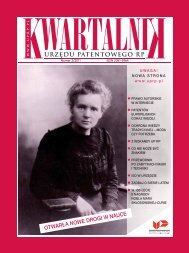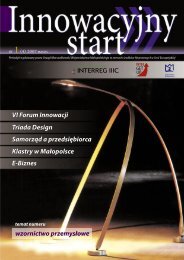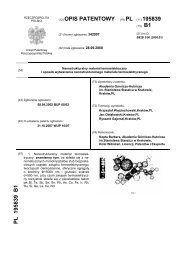Wyd. specjalne/2011 - Regionalny OÅrodek Informacji Patentowej ...
Wyd. specjalne/2011 - Regionalny OÅrodek Informacji Patentowej ...
Wyd. specjalne/2011 - Regionalny OÅrodek Informacji Patentowej ...
- No tags were found...
You also want an ePaper? Increase the reach of your titles
YUMPU automatically turns print PDFs into web optimized ePapers that Google loves.
in Warsaw of 29.03.2007, VI SA/Wa 118/07,unedited quotation in A. Tischner “Prawowłasności przemysłowej. Komentarz.” ed. P.Kostański, Warsaw 2010). In light of the aboveconsiderations, it is obvious that “earliergrant of the right in protection or publicationof the application for a spatial form as a trademarkresults in the loss of novelty feature,i.e. precondition of protection of a design(judgement of the Voivodeship AdministrativeCourt in Warsaw of 24.03.2006 r., VI SA/Wa2339/05, unedited quotation in A. Tischner“Prawo własności przemysłowej. Komentarz.”ed. P. Kostański, Warsaw 2010).Even if the design was made availableto the public, it is still possible to grantit the right in registration when:1) it has been disclosed to a third partyexplicitly or implicitly obliged to maintain confidentiality(e.g. persons obliged to maintainprofessional secrecy);2) it has been disclosed within 12 monthsbefore the date according to which priorityto obtain a right in registration is determined,if the disclosure:a) was made by the designer, his successorin title or a third person with the consentof a right holder,b) was a consequence of an abuse towardsthe designer or his successor in title.The main reason behind setting the additional12-month term, the so-called grace period,was to allow the designer or other holderof the industrial design right to conduct modelbasedtests of products on the market beforea final decision on filing the design applicationfor registration is made.Comparison of the designsA design is new if it has not been disclosedand if it has no identical predecessor. Identicaldesign shall be any design identical to a designpreviously made available or any design differingfrom the available design in insignificantdetails (this approach was also adoptedby the Voivodeship Administrative Court, in itsjudgement of 4 July 2007, in Case VI SA/Wa 652/07). “Novelty” assessment is madein relation to features of the industrial designwhich are visible on the illustration presentedin the documents making up the application.Examination of the design’s novelty is basedonly on those features which are visibleon the graphic presentation of the design.It is maintained in literature that determiningthe importance of a given feature for the finalimage of the design should be a starting pointfor the comparison of various designs. Lackof identicalness of the designs compared canbe demonstrated only through differences betweenthe essential features (inter alia, in Prof.K. Szczepanowska-Kozłowska “Zdolnośćrejestracyjna wzoru w prawie Unii Europejskiej”,PPH 2005, No 3). Meanwhile, M. Poźniak-Niedzielska (“Wzory zdobnicze i ich ochrona”,Warsaw 1978) maintains that a design is notnew when the differences between this designand its predecessor are minor. However,pursuant to the case-law “small differencesbetween the disputable industrial designs, attributingthe feature of novelty to the industrialdesign filed, do not automatically make it original(judgement of the Voivodeship AdministrativeCourt in Warsaw of 21.02.2006 r. VI SA/Wa 1073/05, unedited quotation in A. Tischner“Prawo własności przemysłowej. Komentarz.”ed. P. Kostański, Warsaw 2010).Individual character“Novelty” is not the only condition of protectionof industrial designs. Another one is “individualcharacter”. Pursuant to Article 104 (1) of IPLA,an industrial design shall be consideredto have individual character, if the overallimpression it produces on the informed userdiffers from the overall impression producedon such a user by any design which has beenmade available before the date accordingto which the priority is determined. The designmust differ from the already existing designsthat produce a similar impression.The assumption that the design in questiondoes not have to differ from any existing designbut from designs of the same product(s)in the same industrial sector is advocatedby numerous representatives of the legal approach,e.g. J. Kępiński “Wzór przemysłowy…”,E. Nowińska “Prawo własnościprzemysłowej. Przepisy i omówienie”E.Nowińska, U. Promińska, M. duVall. Warsaw2003). In their opinion, individual charactershould be tested solely with respect to a certainproduct market. According to J. Kępiński,pursuant to the guidelines of Recital 13of the Preamble of the Directive 98/71/ECof 13 October 1998 on the legal protectionof designs of 13 October 1998, the natureof the product to which the design is appliedor in which it is incorporated, and the industrialsector to which it belongs should be takeninto consideration. For example, a well-knownornamental design used on cutlery may givecompletely different impression as a decorativeelement of the kitchen (J. Kępiński “Wzórprzemysłowy….”). On the other hand, M.Poźniak-Niedzielska claims that individualcharacter is the outcome of various elementsdetermining certain distinctiveness of a modelbaseditem. (M.Poźniak-Niedzielska, glossto the judgement of the Supreme Courtof 23.10.2007, IICSK 303/07, OSP 2009, No 6,item 66). Pursuant to Article 105 (4) of IPLA,assessment of whether the questioned designproduces a different impression on the informeduser is based on the overall impressionwhich relates to the design as a whole and notits respective parts. It is therefore a matterof overall impression, overall effect, overallfeeling produced by the questioned designand the registered design – whether the impressionvaries or is identical. This overallimpression is produced by the sum of the featuresof the design visible during normaluse of the item (judgement of the SupremeCourt of 23 October 2007 in Case II CSK302/07,OSNC 2008 no 2, item 52). In addition,according to case-law, “registration of anindustrial design combining features of the previouslyknown designs, if overall impressionproduced by this design differs from impressionproduced by the designs compared”is acceptable (judgement of the VoivodeshipAdministrative Court in Warsaw of 29.03.2007,VI SA/Wa 1716/06, ONSA and WSA 2009,No 1, item 13).Informed userIndividual character is assessed from the perspectiveof the informed user. The notionof the informed user should not be equatedwith the model of an average consumer– properly informed, sufficiently attentiveand wise – possessing knowledge of the caselawconcerning mainly industrial designs. Itis believed that in comparison with the averageconsumer the informed user has a higher thanaverage level of ability to notice differences.M. Poźniak-Niedzielska maintains that the informeduser is more insightful and skilledin a certain area than the average user. He/she is neither the creator or average recipientnor the expert in a given field – he/sheis an “insider”. The informed user is requiredto possess specific qualifications. Therefore,this cannot be a purchaser (consumer) butsomebody using the item and utilising it likean expert. It does not necessarily have to bea final user (M. Poźniak-Niedzielska “Ochrona<strong>Wyd</strong>anie <strong>specjalne</strong> KWARTALNIK URZĘDU PATENTOWEGO RP • 49


